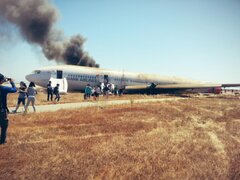
The pilots of an Asiana Airlines flight that crashed at San Francisco International Airport last July were aware that they were coming into the runway too slowly to be safe but did not correct the problem in time, the airline acknowledged in documents released by the National Transportation Safety Board today.
Asiana Airlines Flight 214 ended up hitting a seawall and its tail broke off as it crashed onto the runway on July 6, 2013. Three teenage schoolgirls from China were killed as a result and more than 180 passengers were injured.
But while acknowledging pilot error in not monitoring the Boeing 777’s speed during approach closely enough, Asiana said that warning systems designed by plane manufacturer Boeing did not provide adequate warning of the slow approach for the pilots to correct the problem.
The airline also said that the pilots were hampered by delayed responses from the air traffic control tower—that after requesting clearance to land at 2,000 feet the pilots did not get a response until they had reduced altitude to 600 feet, approximately 43 seconds before impact.
In a separate filing released today, Boeing said that the pilots were aware that their speed was too low at 220 feet—about 20 seconds before impact—but that the pilots still failed to correct the problem.
Boeing’s equipment then signaled a warning that airspeed was dangerously low at about 11 seconds before impact, according to Asiana, leading the pilots to initiate a “go-around,” in which they would abort the landing and retry.
But the go-around maneuver required at least 12 seconds to complete so Boeing’s warnings were too late to be effective. The plane’s attempts to abort the landing led to the tail hitting the runway and breaking off.
Boeing’s Robert Myers was quoted at a previous NTSB hearing that the warning system was not necessarily intended to alert pilots to dangerous landing conditions and that “the original scenario for which we designed the alert was a cruise condition, and so in that case, often there is much more time before the pilot must take action.”
Asiana also said that Boeing’s documentation of the plane’s automatic throttle system was incomplete and it was not clear that the autothrottle would shut down when air speed became too low.
The airline did acknowledge that the pilots should have paid closer attention to the plane’s deteriorating speed.
“Given the pilots’ experience and training, there are no obvious explanations for why they did not recognize the deteriorating airspeed and abandon the approach sooner,” Asiana said in its filing.
A federal report released in December indicated that the pilots were confused about which one of them should make the determination that the plane should make a go-around, further delaying the process.
The man flying the plane, identified as 45-year-old Lee Kang Kuk, was on a training flight and was supervised by 49-year-old Lee Jung Min.
In the report, Lee Kang Kuk indicated that he expected the more experienced pilot to have the final decision, as it would be in Korean culture, while the instructor Lee Jung Min told investigators that the flying pilot was responsible for making those decisions.
The routine flight from Seoul had a total of 307 people on board and led to three fatal injuries of three Chinese schoolgirls who were on their way to a summer camp in Los Angeles.
One 16-year-old girl was found dead on the runway. Another was found in front of the left wing of the jet where she was run over by two responding San Francisco fire vehicles after she was covered in fire-fighting foam and not visible.
A 15-year-old girl was critically injured and died in the hospital days later.
Scott Morris, Bay City News









